DB here:
Can a storyteller be maladroit in using his or her medium and still be worth reading? Can a novelist with a clumsy style be a “good writer”? I’ve posed this question before on this site, and developed an argument about it at length in our book on Christopher Nolan.
Here’s a test case. These are real sentences from books by a novelist many consider one of the great crime/mystery writers of all time.
The knob felt cold and glibly elusive under his touch.
His face was an unbaked cruller of rage.
La Bruja lidded her eyes acquiescently.
I began treacherously touching up my hair via the mirror.
I crawled up onto the seat by means of my hands.
She could feel her chest beginning to constrict with infuriation.
This time the man got up off the bench, taking Quinn’s hand on his shoulder along with him.
Smoke suddenly speared from her nostrils in two malevolent columns. She looked like Satan. She looked like someone it was good to stay away from.
I was probably just a blurred bottle-green offside to her retinas.
“Made it,” Joan Bristol exhaled relievedly.
Seconds went by in packages of sixty.
The foaming laces that cascaded down her were transparent as haze against the light bearing directly on her from the room at her back. Her silhouette was that of a biped.
These passages, and many more like them, were published in books issued by major houses and still in print today. Can anything redeem them?
I’m currently trying to write a book on principles of popular narrative, with a focus on genres of crime and mystery. The project stems from arguments in Reinventing Hollywood and The Way Hollywood Tells It, but I wanted to broaden my inquiry to include theatre and literature as well. One section is about crime writers of the 1940s and 1950s. So naturally I had to include the widely renowned Cornell Woolrich.
Despite his struggles with syntax and word choice, Woolrich has been a perennial source of popular storytelling. Nearly all the novels were brought to the screen soon after publication, and radio versions of the books and short stories were plentiful. By the 2010s his work had inspired over a hundred movies and television shows (directed by, among others, Hitchcock, Truffaut, Fassbinder, and Jacques Tourneur).
That research has led me two further questions. Are there aspects of his work that counterbalance howlers like those above? And what might have led to those stylistic problems? Readers looking for more direct and detailed studies of film versions of his work can go to Francis M. Nevins’ exhaustive biography and Thomas C. Renzi’s careful consideration of adaptations. (And my studies of The Chase, if you want.) Meanwhile, tackling the questions that interest me, I’ll touch on aspects of cinema a little bit. File this blog under Questions of Narrative Across Media.
Breathless reading
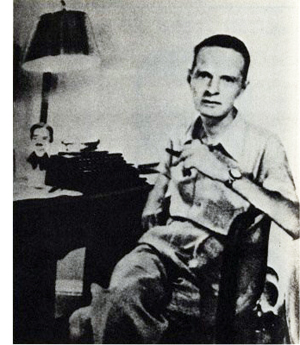
Despite his distinctive sensibility, Woolrich epitomizes some broader narrative strategies of his time. Like all popular writers, he inherited situations, techniques, and themes. To present a bleak, aching world of precarious love and doomed lives, he twisted those conventions into eccentric shapes that added to the Variorum of 1940s mystery storytelling.
For him, one bout of amnesia isn’t enough, so The Black Curtain (1941) doubles it: the hero, already having forgotten his previous identity, is clobbered by some falling bricks and now can’t remember who he just was. The prototypical serial killer of the 1940s is a man, but The Bride Wore Black (1940) lets a woman stalk her victims. Most thriller novelists are content to put one woman in jeopardy per book, but Black Alibi (1942) lines up six. Alternatively, when a woman tries to save her husband from the chair by investigating four suspects, she’s plunged into danger every time she meets one (The Black Angel, 1943).
Woolrich’s plots flout police procedure (his cops are exceptionally willing to help suspects), and the authorities often flounder. Suspense thrillers usually invoke the supernatural only to dispel it, but in Night Has a Thousand Eyes (1945) the authorities fail to save a life because one old man really can predict the future. Not that amateur sleuths fare much better. The unheroic hero of The Black Path of Fear (1945) could hardly be more ineffective; he has to be rescued by the Havana police.
Sometimes the straining for originality snaps. Critics have long pointed out improbabilities and contradictions in the plots. Woolrich’s most devoted chronicler, Francis M. Nevins, warns of “chaotic ambiguities.” The chronology of Rendezvous in Black (1948) is impossible, while the climactic revelation of I Married a Dead Man (1948) is arguably incoherent. Convenient coincidences abound. Add to this a hypertrophied style that in every book slips into unabashed weirdness. (See above.)
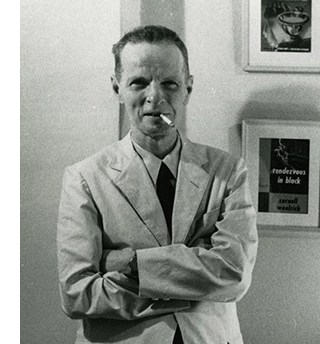
Admiring readers excuse the faults by testifying that Woolrich’s evocation of tension keeps the pages turning. “Headlong suspense created by total, unrelieved anxiety,” noted Jacques Barzun. “Breathless reading is the sole pleasure.” Raymond Chandler called him the “best idea man” among his peers, but admitted, “You have to read him fast and not analyze too much; he’s too feverish.”
What keeps us reading? For one thing, the outré story situations. A couple hurrying to leave New York must clear the man of murder before the bus leaves (Deadline at Dawn, 1945). A killer stalks a city, but it’s not a human: it’s (apparently) a black jaguar escaped from a sideshow (Black Alibi). A mail-order bride seems unacquainted with things she wrote in her letters (Waltz into Darkness, 1947). Most famously, a man laid up in his apartment thinks he sees traces of a killing through a window across the courtyard (“Rear Window,” 1942).
Outrages to plausibility carry their own allure. What, we ask, might come of these wild mishaps? A train crash kills a husband and his pregnant wife. In the melée an abandoned woman, also pregnant, is mistaken for her and welcomed by the husband’s family. Conveniently, the in-laws have never seen the wife (I Married a Dead Man, 1948) A man accused of murder has an alibi, to be provided by a woman he met in a bar and took to a show. Trouble is, she’s vanished. All the witnesses deny she existed (Phantom Lady, 1942).
The development of the action also presents intriguing reversals. The man gulled by the fake mail-order bride falls in love with her. People who claim not to have seen the phantom lady wind up dead. The woman trying to exonerate her husband falls in love with the real killer and dreams about him even after he has killed himself.
The game is afoot
Woolrich’s novels tend to rely on two basic plot patterns, both based on the hunt. In one, amateurs try to solve a crime and move from suspect to suspect. Our viewpoint is mostly tied to the investigators. In the other pattern, a serial killer stalks a string of victims, and here Woolrich is more innovative. Normally, the serial-killer plot either concentrates on the killer’s viewpoint, as in the novels Hangover Square (1941) and In a Lonely Place (1947), or concentrates on the investigators, as in Ellery Queen’s Cat of Many Tails (1949). A few constantly bounce the spotlight among all the parties—killer, victims, and investigators—as in Fritz Lang’s film M (1931) and Philip MacDonald’s novel X v. Rex (1933).
Woolrich by contrast emphasizes the victims’ viewpoints. The killer might appear only at the beginning and end (Rendezvous in Black) or get introduced at intervals in brief, objective scenes (The Bride Wore Black). Less space is devoted to the investigators, although they gain prominence as the crimes pile up. Woolrich puts his energies into building waves of suspense as one target after the other confronts death.
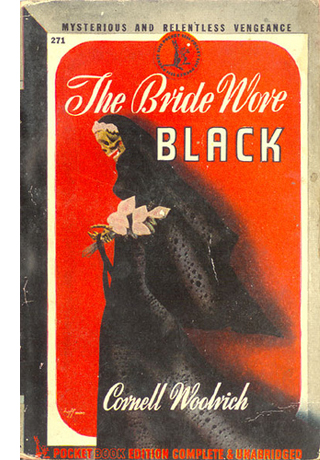
Something else now assailed her, again from without herself, but of a different sensory plane than hearing this time. A prickly sensation of being watched steadily from behind, of something coming stealthily but continuously after her, spread slowly like a contraction of the pores, first over the back of her neck, then up and down the entire length of her spine. She couldn’t shake it off, quell it. She knew eyes were upon her, something was treading with measured intent in her wake.
This passage is part of a ten-page account of the woman’s wary progress through a night street, rendered wholly from her viewpoint.
Woolrich’s other basic plot pattern, the investigation of a murder, plays up the role of fear as well. His amateur detectives, lacking official firepower, are constantly facing danger from the suspects they track.
Fright was like an icy gush of water flooding over them, as from burst pipe or water-main; like a numbing tide rapidly welling up over them from below. [Deadline at Dawn]
In both of his favored plot schemes, the plunges into characters’ minds and bodies help fill out a full-length novel. If you play down other lines of action (professional police investigation, killer’s mental life), you need to dwell on the reactions of the victims or amateur detectives.
Yet this very emphasis is one source of the stylistic howlers. In expanding his suspense scenes, Woolrich’s prose sometimes fails him. Needing to spin out lots of words evoking an ominous atmosphere, he’s tempted to pileups like this:
And the path that had led me to it through the night had been so black and so full of fear, and downgrade all the way, lower and lower, until at last it had arrived at this bottomless abyss, than which there was nothing lower. [The Black Path of Fear]
Such rodomontade carries the 1940s emphasis on subjectivity to paroxysmic limits.
He recruits other techniques of popular storytelling. They keep his action moving forward through time and plunging inward into the unfolding scenes. And some can help mask story problems.
By hinging his story around a search for a killer or a victim, Woolrich’s plots tend create a string of one-on-one encounters. Rather than disguising the episodic quality of these, he sharpens them by breaking the action into distinct blocks. Those blocks are presented as a checklist agenda, Woolrich’s equivalent to the closed circle of suspects we find in the classic weekend-house-party detective story.
The Black Angel is a simple instance.
After an initial cluster of five chapters presenting Kirk Murray sentenced to death, we follow Kirk’s wife Alberta as she seeks the true killer. Her efforts are given in five parallel chapters, each inset a bit and tagged with a telephone number. One that Alberta finds scratched out in an address book is presented just that way in the chapter title: “Crescent 6-4824.” Because at the climax she returns to one of the four suspects, another title gets recycled: “Butterfield 9-8019 Again (And Hurry, Operator, Hurry!).”
A more complicated example of modularity is The Bride Wore Black. It’s broken into five parts, each titled with the name of a victim. Each part contains three sections.
“The Woman” shows the vengeful bride launching a new false identity. The part’s second section, titled with the victim’s name, shows how the murder is accomplished. A third section offering “Post-Mortem” on the victim consists of documents and conversations among the police. Viewpoints are rigidly channeled as well. Each “Woman” section is handled in objective description, while each victim section presents the targeted man as the center of consciousness. The book could be mapped out on a spreadsheet.
The modular layout and rigorous moving-spotlight narration risk choppiness, yielding something like a set of short stories. But the tidy exoskeleton can make the plot seem rigorously organized, even while it masks problems of time and causality. And the very arbitrariness of the pattern creates a sort of meta-curiosity. Like the teasing tables of contents in 1920s and 1930s detective fiction, a Wooolrich checklist of suspects or victims makes us aware of a larger rhythm. How will this pattern be filled out?
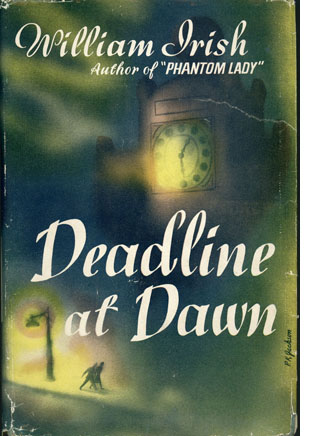
Facing a ticking clock wedded to a clear-cut pattern, we become sensitive to variations among the modules. The victim-centered chapters of The Bride contrast the personalities and private lives of the male victims, along with Julie’s resourceful methods of murder, and the last chapter breaks the three-part format by inserting a flashback dramatizing the fatal wedding. Rendezvous in Black revives the shooting-gallery structure of Black Angel and The Bride, adding a schedule that sets each murder on May 31st of different years. Within this regularity (“The First Rendezvous,” etc.), viewpoints multiply gradually so that the interplay of characters’ range of knowledge becomes richer.
The modular structure shows up in milder ways. Black Alibi tags its chapters with victims’ names and concentrates on one woman’s terror at a time, with each chapter concluding with an exchange among investigators. Deadline at Dawn and Phantom Lady alternate scenes between two characters embarked on parallel investigations. Night Has a Thousand Eyes, in some ways the most ambitious of the books, embeds the checklist within the police investigation. As teams of cops trace parallel leads, their efforts are crosscut with the target under threat, waiting with his daughter and a cop.
A simpler, more poignant, rhyme-and-variations effect is supplied by a prologue and epilogue in I Married a Dead Man. The prologue’s first-person narration, set off from the central chapters’ third-person narration, finishes: “We’ve lost. That’s all I know. We’ve lost, we’ve lost.” An epilogue rewrites the prologue and yields closure: “We’ve lost. That’s all I know. And now the game is through.” In such ways, Woolrich brings the overt compositional symmetry of both “serious literature” and the puzzle-driven detective story into the thriller.
Sweating the small stuff
Henry James, 1913; Cornell Woolrich, ca. 1927.
By the 1920s, ambitious Anglo-American writers in both popular genres and “advanced” literature had fallen under the sway of a new model of the novel. Henry James had argued that if the novel was to be a true art form, it needed more compositional rigor, a patterned architectural solidity. He also advocated for a self-conscious control of viewpoint and a greater commitment to concrete presentation of action. (“Dramatize, dramatize!”) A little later, Joseph Conrad’s books had demonstrated the power of shifting viewpoints and multiple narrators, as well as an emphasis on the power of sight.
Popular writers of the nineteenth century, notably Dickens and Wilkie Collins, had already made use of some of these techniques, as did more highbrow efforts, like Robert Browning’s verse novel The Ring and the Book (1868-1869). But in the wake of James and Conrad, tastemakers erected these principles into strict norms for well-made novels. These precepts were set out explicitly in Percy Lubbock’s The Craft of Fiction (1922), and they were picked up in popular writing manuals as well.
Many mainstream fiction writers (and dramatists) took up the techniques promoted by the James-Conrad-Lubbock tradition. Middlebrow novels employed block construction, played with multiple viewpoints, and included an explicit “exoskeleton” of labeled parts pointing up a self-conscious architecture. Joseph Hergesheimer’s Java Head (1919) spreads nine characters’ viewpoints across ten parallel chapters. Detective fiction wasn’t immune to the new methods. Conrad’s exploration of optical viewpoint has a contemporary counterpart in the Chestertonian grandeur of the mystery story “The Hammer of God” (1910). Father Brown is standing at the top of a church.
Immediately beneath and about them the lines of the Gothic building lunged outwards into the void with a sickening swiftness akin to suicide. . . . When they saw [the church] from below, it sprang like a fountain at the stars; and when they saw it, as now, from above, it poured like a cataract into a voiceless pit.
The writers of High Modernism revised the James-Conrad-Lubbock norms, pushing toward more difficult manipulations of time, viewpoint, and subjective states. Faulkner’s The Sound and the Fury assigns different narrational voices to its four-block layout, but these make the story world and the time scheme opaque. (Even if you master the stream-of-consciousness technique, you still have to figure out that one character is called by two names and two characters have the same name.)
Like many other writers, Woolrich pulls several post-James techniques into genre literature. His block construction, marked by strict times and viewpoints, along with his labeling of plot phases, owes something to this tradition, as well as to the clever construction of detective stories of the 1920s and 1930s (Ellery Queen, Anthony Berkeley, et al.). He borrows another narrative strategy as well: granular scene description keyed to a character’s sensations and feelings. We get a kind of hypertrophy of Lubbock’s “Show, don’t tell.” In reply to James, Woolrich in effect declares, “Overdramatize, overdramatize!”
In his uncompleted autobiography, Woolrich reflected on his early efforts to compose scenes. A man takes a hotel elevator, and instead of writing, “He got in, the car started; the car stopped at the third and he got out again,” the young Woolrich would pad the trip out to a page or more. This was amateurish, he thought at the end of his life. Yet this sort of expansion of action moment by moment is a hallmark of his 1940s novels. Perhaps it’s what Chandler had in mind when referred to Woolrich “getting deep into every scene.”
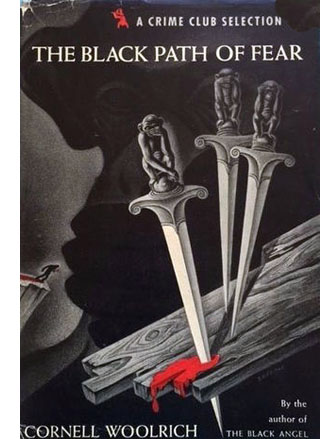
When I’d finished telling it to her the candle flame had wormed its way down inside the neck of the beer bottle, was feeding cannibalistically on its own drippings that had clogged the bottle neck. The bottle glass, rimming it now, gave a funny blue-green light, made the whole room seem like an undersea grotto.
We’d hardly changed position. I was still on the edge of her dead love’s cot, inertly clasped hands down low between my legs. She was sitting on the edge of the wooden chest now, legs dangling free. . . .
The behavior of light, the insistence on color, the description of the characters’ postures and gestures—these are typical of Woolrich’s scenes.
Even the simplest action employs Lubbock’s “scenic method” to a disconcerting degree. To quote adequately would take pages, but some samples can suggest just how distended and detailed even minimally functional scenes are.
I reached out for a little lamp he had there close beside the bed and clicked it on. Twin halos of light sprang out, one at each end of the shade, and showed up our faces and a little of the margin around them. The shade itself was opaque, to rest the eyes.
Then I just sat back and waited for the shine to percolate through to him, sitting on the bias to him. It took some time. He was sleeping like a log. [The Black Path of Fear]
Any other writer would have retained just the first sentence and the last (but maybe not with the clichéd phrasing). Who cares about the design of a light fixture, or whether the shade rests the eyes? Yet Woolrich feels the need to show and tell as much as he has room for.
A woman comes to a Bowery bar looking for a murder suspect. After a page and a half of banter with the bartender, she finds her quarry hunched over a tabletop. Another page is devoted to rousing him.
He moved slightly, and I saw him looking downward at the floor around his feet. Looking around for something on that filthy place where people stepped and spat all day long. In a moment more I had guessed what he was looking for and I opened my handbag and took out the cigarettes I had provided myself with and held the package ready, with one protruding, as my first silent overture.
His eyes stopped roaming suddenly, and they had found the small arched shape of my shoe, planted there unexpectedly on that floor beside him, and the tan silk ankle rising from it. [The Black Angel]
It takes another page for the drunk to accept the cigarette, and three more for the woman to question him. But he’s too incoherent, so she parks him in a hotel and resumes questioning him the next day—a process that takes fifteen pages and includes detailed descriptions of the hotel room, the light filtering in, and the two characters’ shifting positions in space.
This writer has Roderick Usher’s “morbid acuteness of the senses.” Scenes are thick with smells and sounds. One virtuoso section of Rendezvous in Black is all noises and speech because our center of consciousness is a blind woman. Above all, Woolrich’s scenes revel in optical point of view.
Movies on the page
Sometimes the observer is imaginary, looking at things alongside the character. Detective Wanger enters a murder scene.
They seemed to be playing craps there in the room, the way they were all down on their haunches hovering over something in the middle of the floor. You couldn’t see what it was, their broad backs blotted it out completely. It was awfully small, whatever it was. Occasionally one of their hands went up and scratched the back of its owner’s rubber-tired neck in perplexity. The illusion was perfect. All that was missing was the click of bone, the lingo of the dicegame. [The Bride Wore Black]
Actually, the policemen are interrogating a boy whose father has been murdered. Presumably Wanger doesn’t take the huddle for a craps game. We’re given the mistaken impression of a novice observer who’s watching from a particular angle.
More often, it’s the character who occupies a definite station point, determined by foreshortening and perspectival distortion. The supreme example is of course the short story “Rear Window” (1942) whose original title was “Murder from a Fixed Viewpoint.” One of his clumsy passages in another story tries for the same kind of positioning: “He turned and looked up, startled, ready to jump until he’d located the segment of her face far up the canal of opening between them.”
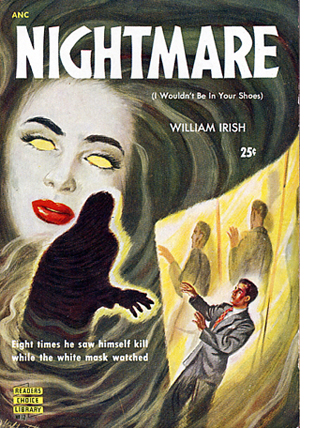
There was some sort of a widespread black V railing him off from the window. Whatever it was, there was just a sliver of it showing above the upward inclination to which the window sill deflected my line of vision. All it did was strike off the bottom of his undershirt, to the extent of a sixteenth of an inch maybe. But I hadn’t seen it there at other times, and I couldn’t tell what it was.
Jeff’s tightly focused attention contrasts with his neighbor Thorwald’s casual sweeping looks toward the courtyard. The climax will come when Thorwald realizes he’s been Jeff’s target, and Jeff sees in the murderer’s look “a bright spark of fixity” that “hit dead-center at my bay window.”
A similar effect occurs at the climax of “The Boy Cried Murder” (aka “Fire Escape”) of 1947, the source of the film The Window (1949). Buddy has been sleeping on a fire escape and is awakened by a murder he watches through a slit in the window shade. The woman comes toward him.
She started to come over to where Buddy’s eyes were staring in, and she got bigger and bigger every minute, the closer she got. Her head went way up high out of sight, and her waist blotted out the whole room. He couldn’t move, he was like paralyzed. The little gap under the shade must have been awfully skinny for her not to see it, but he knew in another minute she was going to look right out on top of him, from higher up.
Again, there’s a stylistic slip (of course she’ll be higher up if she looks out on top of him), but it’s a byproduct of an effort to capture a character’s optical viewpoint.
Sometimes that effort seems pure gimmickry.
I hurried down the street, and the intermittent sign back there behind me kept getting smaller each time it flashed on. Like this:
MIMI CLUB
Mimi Club
mimi club
I could tell because I kept looking back repeatedly, almost in synchronization with it each time it flashed on. . . . [The Black Angel]
Yet even the gimmick seems an effort toward a peculiar kind of vividness—that of a film. The passage imitates alternating shots of the woman looking and the withdrawing club sign. If Woolrich’s modular structure is indebted to strains in modernism and popular fiction, the dense, over-visualized scenes inevitably suggest cinema.
Woolrich worked as a Hollywood screenwriter for a couple of years and had a lifelong affinity for movies. The books often use cinematic analogies and metaphors, and the characters are frequent moviegoers. (In a 1936 story, “Double Feature,” a gangster takes a woman hostage in a projection booth.) Supposedly Woolrich spent his last years holed up drinking and watching old films on TV. No surprise, then, that some passages echo the look and feel of Hollywood scenes.
Granted, many writers, highbrow and lowbrow, were imitating cinema in Woolrich’s day. Some incorporated filmlike montage sequences to suggest dreams and stream of consciousness. But Woolrich goes farther than most. In Fright (1950), two paragraphs headed “Still Life” survey an empty room that shows signs of interrupted activity—a crumpled newspaper, a note, a burning cigarette, a swaying lamp chain. The passage mimics the sort of tracking shot over details we find in 1940s cinema, continuing for a page until it climaxes in a close-up panning over a body jammed against the door.
When a man realizes his beloved woman lies dead on the bed, a dash can imitate a cut:
But her eyes were still blurry with slee—
His hand stabbed suddenly downward toward the hairbrush, there before her. [Rendezvous in Black]
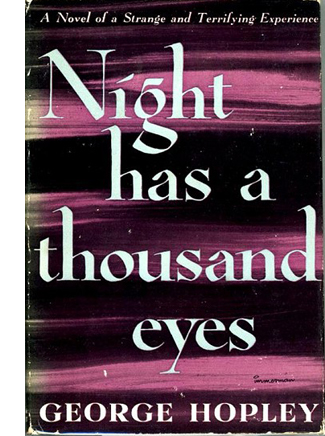
I sat there waiting for him, cigarette in my hand, light-blue swagger coat loose over my shoulders. . . .
I sat there waiting for him, rust-colored swagger coat loose over my shoulders. . . .
I sat their waiting for him, plum swagger coat over my shoulders. . . .
I sat there waiting for him, fawn swagger coat over my shoulders. . . .
I sat there waiting for him, green swagger coat over my shoulders. . . .
I sat there waiting for him, black swagger coat over my shoulders, as I’d already sat waiting so many times before.
The modular approach ruling the books’ overall architecture gets carried down into the texture of scenes, creating parallel mini-blocks that convey the daughter’s anxious acquiescence to her father’s obsession.
Woolrich’s literary optics have strong affinities with cinema. We get an effort to mimic a subjective tracking shot as one heroine circles a garden.
The little rock-pool in the center was polka-dotted with silver disks, and the wafers coalesced and separated again as if in motion, though they weren’t, as her point of perspective continually shifted with her rotary stroll. [I Married a Dead Man]
Likewise, a woman approaching a man slowly tapers into focus.
She was up to him eye to eye before he could even take her in in any kind of decent perspective. His visualization of her had to spread outward in concentric, radiating circles for those eyes, staring into his at such close-range.
Brown eyes.
Bright brown eyes.
Tearfully bright brown eyes.
Overflowingly tearful bright brown eyes.
Suddenly a handkerchief had come up to shut them off from his for a moment, and he was able to steal a full-length snapshot of her. Not much more. [The Black Curtain]
This is just showboating, but it’s uniquely Woolrich showboating.
The same goes for a passage struggling to describe people at a bar as if they were framed in the flattening view of a telephoto shot.
There were eight people paid out along it. They broke into about three groups, each self-contained, oblivious of the others, but he had to look close to tell where the divisions came in. Physical distance had nothing to do with it; they all stretched away from him in an unbroken line. It was the turn of the shoulders that told him. The limits of each group were marked by a shoulder turned obliquely to those next in line beyond. They were like enclosing parentheses, those shoulders. In other words, the end men in each group were not postured straight forward, they turned inward toward their own clique. The groupings broke thus: first three, then a turned shoulder, then three again, then another turned shoulder, then finally two, standing vis-à-vis. [Deadline at Dawn]
Few writers would strive so hard to capture the exact look of figures in space. It will take another page for the viewpoint character to realize that a left-handed drinker has stepped out, because one beer mug isn’t empty and the handle is pointing in a different direction than the others.
It’s not hard to imagine such scenes as Hitchcockian POV shots. In Waltz into Darkness, Durand notices a colonel and his lady in the reflection of the “thick, soapy greenish” window of a café. At first the view yields a blob sporting “three detached excrescences”: a feather in a hat, a bustle, and “a small triangular wedge of skirt.” Eventually this monstrosity draws away “into perspective sufficient to separate into two persons.” Conrad’s “impressionism,” aiming to capture the limits of physical point of view, reaches a new height with Woolrich’s account of exact but imperfect vision.
Some provisional answers to my Woolrich questions run like this. The ingenuity of structure and the inherent fascination of the situations somewhat offset the problems of style. Most of his novels tap our primal interest in the hunt, and if things don’t always pay off neatly, the pursuit has enough detours, hurdles, and pitfalls to sustain interest.
And the writing isn’t totally disastrous. There are well-written passages in every Woolrich novel. Many of the howlers arise from the keyed-up emotion he tries to squeeze out of every scene. Others stem from sheer overwriting and padding, and probably the habit Fisher notes of seldom revising. But other errors are a byproduct of his effort to put every bit of action starkly before us. Straining for sensory vividness lures him into clumsiness (“triangular wedge,” as if all wedges weren’t triangular).
More generally, in both virtues and faults, he displays a dogged, frenzied obedience to the narrative traditions he inherited, and an urge to innovate within them, however eccentrically. Henry James asserted that “a psychological reason is, to my imagination, an object adorably pictorial.” A Woolrich character puts it in a typically convoluted way: “Every time you think of anything, there’s a picture comes before you of what you’re thinking about.”
Beyond the books of Nevins and Renzi, valuable appreciations of Woolrich include Nevins’ essay in his collection Cornucopia of Crime: Memories and Summations (Ramble House, 2010), 53-71; Geoffrey O’Brien’s comments in Hardboiled America: Lurid Paperbacks and the Masters of Noir, second ed. (Da Capo, 1997), 97-100; and James Naremore’s essay on his site, “An Aftertaste of Dread: Cornell Woolrich in Noir Fiction and Film.” For a topical overview of Woolrich’s output, see Mike Grost’s entry on him.
I took Steve Fisher’s account of Woolrich’s writing process from “I Had Nobody,” The Armchair Detective 3, 3 (1970), 164. The quotation from Jacques Barzun comes from Barzun and Wendell Hertig Taylor, A Catalogue of Crime, rev. ed. (New York: Harper & Row, 1989), 561. The Raymond Chandler remarks appear in a 1949 letter to Alex Barris in Raymond Chandler Speaking, ed. Dorothy Gardner and Kathrine Sorley Walker (Plainview, New York: Books for Libraries, 1971), 55. I’ve discussed Mitchell Wilson’s essay, “The Suspense Story,” The Writer 60, 1 (January 1947) at greater length in the online essay “Murder Culture.” More generally, Woolrich’s narrative strategies accord with several I chart in Reinventing Hollywood: How 1940s Filmmakers Changed Movie Storytelling, including the notion of the Variorum.
Woolrich’s early, Fitzgerald-influenced novels reveal seeds of the style to come. A random page from Manhattan Love Song (1932) yields a scene of the hero talking to two women: “Instantly I saw a gleam of admiration light each of their four eyes.”
Astonishingly, Woolrich’s prose glitches don’t rate a mention in Bill Pronzini’s hilarious compilations of bad writing, Gun in Cheek: A Study of “Alternative” Crime Fiction (Coward McCann, 1982) and Son of Gun in Cheek (Mysterious Press, 1987). Pronzini tactfully limits his citations of the classics, only mentioning one Raymond Chandler line: “In spite of his weathered appearance, he looked like a drinker.” Pronzini can find no faults in my personal Style canon: Rex Stout, Donald Westlake (here and here), and Patricia Highsmith.
Speaking of bad writing, alert reader David Koepp calls my attention to this funny examination of the style of Dan Brown’s novels.
There’s more on these issues in the entry “The 1940s are over, and Tarantino’s still playing with blocks.” I discuss The Window in “The eyewitness plot and the drama of doubt.”
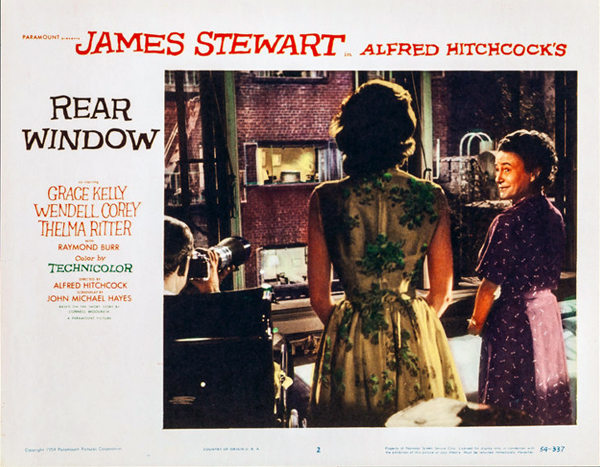
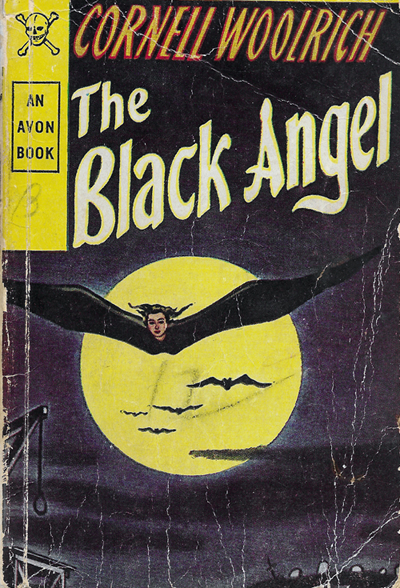
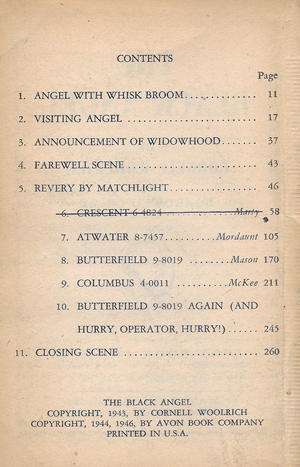
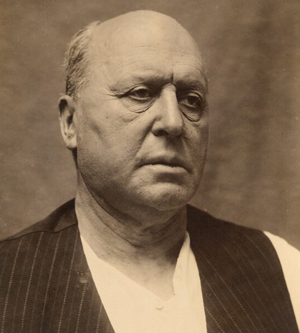
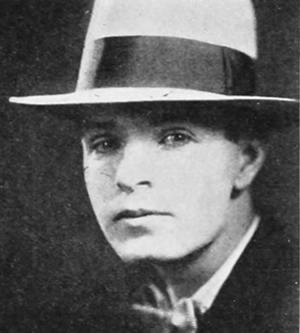
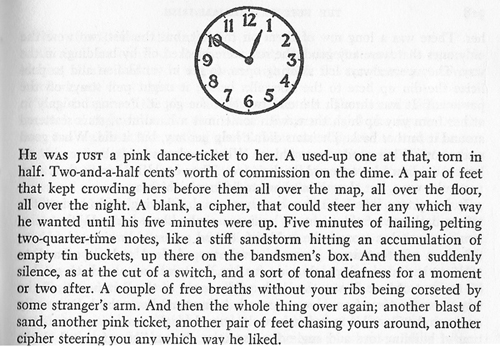
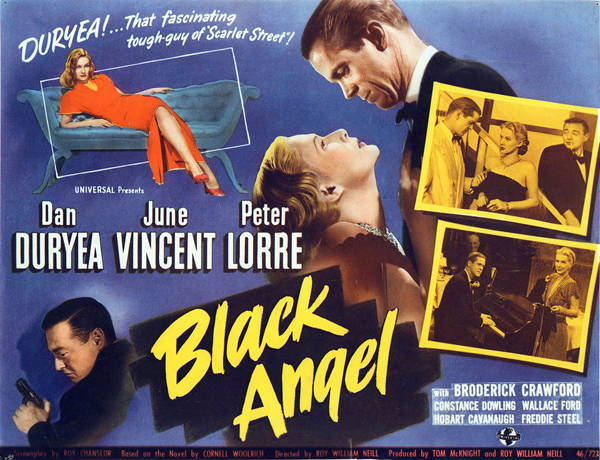
0 comments:
Post a Comment